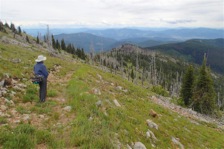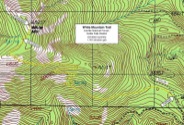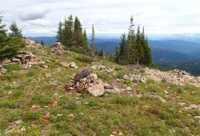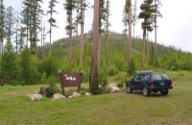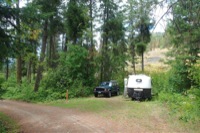Less Traveled Northwest
Day Hikes for the Adventurous
White Mountain Trail
Hike Rating: Moderate
Hike Length: 6.9 miles roundtrip
Elevation Gain: 1,740’
Trailhead Elevation: 5,190’
Best Season: May to September
Driving Access: Any vehicle, with care
Plus Points
• A premier view hike, with panoramic vistas over the southern Kettle River Range
• Variety of landscapes, from fir forests to rocky talus slopes to high alpine meadows
• Carpets of wildflowers in early summer — lupine, paintbrush, larkspur and buckwheat
• Picturesque silver snags in the high meadows, still recovering from a 1988 wildfire
• A sacred mountain to Native Americans, with vision quest cairns along summit ridge
• A very well-built trail on a good grade, though seemingly not heavily-traveled
Minus Points
• Not much shade on the upper slopes, so try to get to an early AM start on hot days
• Afternoon thunderstorms may be a lightning hazard on exposed slopes and ridges
Download (PDF, 772 KB): Photos of White Mountain Trail
Download (PDF, 766 KB): Topo Map for White Mountain Trail
Download (PDF, 618 KB): Road Map for White Mountain Trail
Trail Notes
From the trailhead parking area, the trail descends across a broad saddle, through thickets of lodgepole, larch and alder, all regenerating from the 1988 fire. At 0.3 miles, the trail ascends on a good grade as it traverses the flank of a prominent ridge, through thick alder, thimbleberry and willow that crowd the path, with a pure larch overstory. Rounding the top of the ridge, the first views are down the Hall Creek watershed onto the Colville Indian Reservation. At 0.8 miles, the trail crosses a talus field of white/grey granite rocks, the first of many to come.
Well to the west around the mountain, the trail begins a series of switchbacks up a fir-covered slope, between the wide talus fields on the mountain's south face. Blue lupine form carpets in the grassy understory here in early July. Look for a sign to a piped spring a few yards off the trail on one of the east switchbacks. At 1.9 miles and 6,000', the trail leaves the fir-covered slope and begins a long traverse across open alpine meadows and white granite talus. Prominent here are silver snags killed in the 1988 fire, plus profusions of sun-loving wildflowers such as paintbrush, buckwheat, phlox and yarrow.
At 3.0 miles, the trail tops out onto the broad rounded crest of the southwest ridge of White Mountain, then descends northward through thick alpine firs. Just 200 yards from the ridge crest, in a wildflower meadow, look for a faint trail climbing uphill to the east, with a faded "Trail" sign on a tree. Past the sign, this trail is covered with fallen silver snags, but hikers can work their way cross-country north up the ridge, picking up the open trail again near the summit. On the 6,920' peak, one finds the old stone foundation of the lookout, plus numerous rock cairns in the summit talus fields, built by vision-questing Native Americans. Enjoy the long views east over the Columbia River Valley and west to the peaks of the Okanogan Highlands — then return as you came.
Road to Trailhead
From the junction of Hwy 395 and Hwy 20 west of Kettle Falls, drive west on Hwy 20 for 10.3 miles and turn left (south) onto South Fork Sherman Creek Road (Forest Road 2020). Coming from the west, this good gravel road is also accessible off of Hwy 20 at 3.6 miles east of Sherman Pass.
Drive 6.5 miles on Road 2020 to a junction with Barnaby Creek Road (Forest Road 2014). Continue on Road 2014 for 4.1 miles, then turn right (south) onto Road 250. This road junction is also accessible from the east on Road 2014, about 9.8 driving miles from the Lake Ellen Campgrounds. Follow Road 250 for 4.3 miles to the signed trailhead on the right (west). All these roads are good gravel tracks, passable by any vehicle.
Camping Options
On the east side of the Kettle Range, about 14 miles from the trailhead, are two secluded USFS campgrounds at Lake Ellen, located at each end of the 75-acre lake. The east campground has 11 sites, suitable for tents and small camping trailers, with picnic tables, fire rings and tent pads. The west campground has 5 small campsites, plus a fishing dock and boat ramp. Both campgrounds have vault toilets, but no drinking water or garbage disposal. Camping fees were $6.00 a night in 2016.
Also on the east side and about 17 miles from the trailhead is the USFS Canyon Creek Campground on Highway 20, 7.7 miles west from the Hwy 395 junction. Here are 12 campsites with picnic tables and fire rings, located in a shady lodgepole pine forest about a quarter mile from the highway. There are two vault toilets, but no drinking water or garbage disposal. Camping fees in 2016 were $6.00 per night.
Just east of Sherman Pass on Highway 20, about 17 miles from the trailhead, the USFS Sherman Overlook Campground has been closed for the 2013-16 seasons, due to hazard trees. However, less formal, but still developed campsites are found nearby to the north on the Albian Hill Road (Forest Road 2030) at the Jungle Hill and Wapaloosie Trailheads. Both of these sites have a vault toilet, but no drinking water and no camping fees.
Finally, for those campers entirely self-contained with their own water and sanitation, it's possible to camp right in the large parking area at the White Mountain Trailhead. There's plenty of room for camping setups of all sizes, from large trailers to small tents.
Agency Contact: Colville National Forest, Kettle Falls District, (509) 738-7700
DISCLAIMER: Every effort has been made to ensure the accuracy of this information, but the authors do not guarantee that it is either current or correct. The reader assumes full responsibility for any use of this information, and is encouraged to contact local public land agencies to inquire about current conditions before traveling.
Page last updated: 2/1/17

